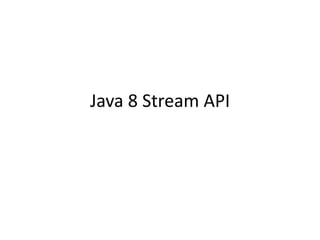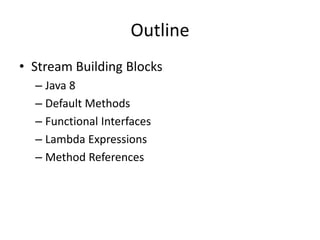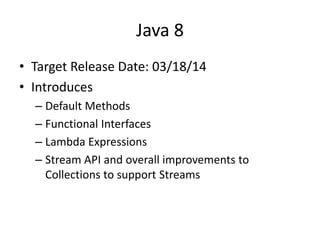The document outlines Java 8's Stream API. It discusses stream building blocks like default methods, functional interfaces, lambda expressions, and method references. It describes characteristics of streams like laziness and parallelization. It covers creating streams from collections, common functional interfaces, and the anatomy of a stream pipeline including intermediate and terminal operations. It provides examples of common stream API methods like forEach, map, filter, findFirst, toArray, collect, and reduce.

























![Common Stream API Methods Used
• Object[] toArray(Supplier)
–Reads the Stream of elements into a an
array
–Example
Employee[] empArray =
employees.toArray(Employee[]::new);
Create an array of Employees out of the
Stream of Employees](https://image.slidesharecdn.com/java8streams-151227101128/85/Java-8-streams-26-320.jpg)


![Common Stream API Methods Used
• T reduce(T identity, BinaryOperator)
• You start with a seed (identity) value, then combine
this value with the first Entry in the Stream, combine
the second entry of the Stream, etc.
– Example
Nums.stream().reduce(1, (n1,n2) -> n1*n2)
Calculate the product of numbers
• IntStream (Stream on primative int] has build-in
sum()
• Built-in Min, Max methods](https://image.slidesharecdn.com/java8streams-151227101128/85/Java-8-streams-29-320.jpg)










![Parallel Streams
• Main Code
System.out.print("Serial version [11 entries]:");
timingTest(googlers());
int numProcessorsOrCores =
Runtime.getRuntime().availableProcessors();
System.out.printf("Parallel version on %s-core
machine:",
numProcessorsOrCores);
timingTest(googlers().parallel() );](https://image.slidesharecdn.com/java8streams-151227101128/85/Java-8-streams-40-320.jpg)
![Parallel Streams
•Results
Serial version [11 entries]:
11.000 seconds.
Parallel version on 4-core
machine: 3.000 seconds.](https://image.slidesharecdn.com/java8streams-151227101128/85/Java-8-streams-41-320.jpg)


